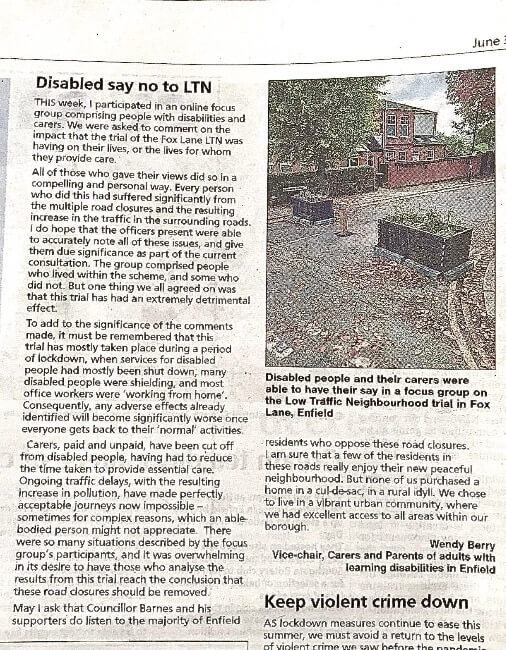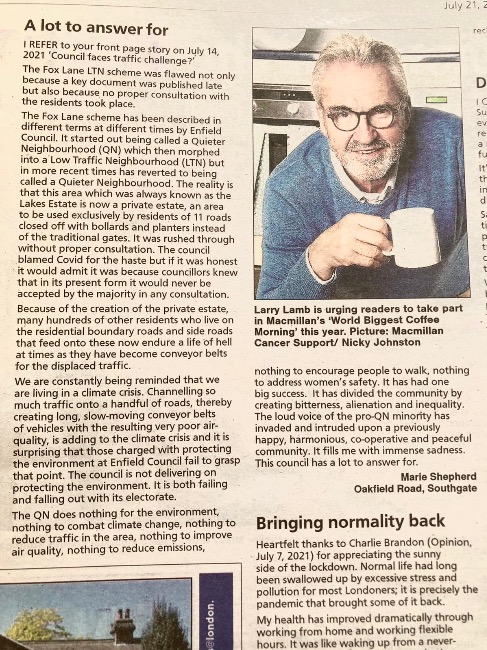Forum topic: Fox Lane quieter neighbourhood: More information published as consultation is extended to July
Fox Lane quieter neighbourhood: More information published as consultation is extended to July
12 May 2021 18:38 #6038- PGC Webmaster
Share
![]()
![]()
 Email
Email

Enfield Council has published further information about how it will be assessing the success of the Fox Lane quieter neighbourhood. The consultation period has been extended until 11th July and a webinar to update residents has been scheduled for 26th May. Data on traffic levels and speeds on surrounding roads is currently being collected. There will be further monitoring of traffic levels in the summer. In the autumn the council will be reporting on all monitoring activity and the outcomes of public consultation and will take a decision to either make the scheme permanent or remove it.
Online consultation
The deadline for filling in the online consultation is now 11th July. You can fill in the survey more than once if you have changed your views or wish to add further comments.
Online event on 26th May (webinar)
The project team will brief about the monitoring and evaluation plan, consultation and engagement activities, the Equalities Impact Assessment, and an overview of next steps. There will be a presentation followed by an opportunity to ask questions. To participate you need to register by 5pm on 26th May.
New documents
The council has published two new documents and a further two will become available before the webinar on 26th May:
- Project rationale
- Monitoring plan
- Communications and engagement plan (not yet available)
- Approach to equalities impact assessment (not yet available)
There are also two new maps of monitoring points within the quieter neighbourhood and on nearby streets:
Project rationale
The project rationale documentstarts by placing the quieter neighbourhood scheme in the wider context of national, London-wide and borough policies and strategies:
The Fox Lane Area Quieter Neighbourhood is delivered in the context of local, regional and national policies and strategies that seek to respond to the climate emergency, reduce traffic congestionand increase levels ofphysical activity, and post-pandemic, to enable a green recovery. Nationally the government has committed to achieving net zero carbon emissions by 2050 and is supporting local authorities to encourage sustainable transport through its Active Travel Fund and the 2020 national walking and cycling strategy, Gear Change.
Across London, the 2018 Mayor's Transport Strategy (MTS) sets the overall direction and city-wide objectives for transport. The MTS set a target for 80% of all tripsto be made on foot, by bicycle or by public transport by 2041.
The 2019 Enfield Transport Strategy sets out how the council will deliver the MTS locally. Key objectives of the Enfield Transport Strategy include firstly the delivery of measures that encourage more walking and cycling, and secondly the promotion of safe, active and sustainable journeys to school. The council’s emerging Health and Wellbeing Strategy aims to reduce health inequalities and prioritises enabling active lifestyles. Creating an environment in which people feel comfortable walking and cycling for everyday journeys will help more people to be physically active.
Traffic monitoring

The monitoring plan document sets out what data the council will monitor and how it will do the monitoring.
Data and insights will be collected from a range of sources. Reporting on each of these sources will be brought together in a formal report which will outline the data collected, methodologies for any data analysis, our findings from the data, and provide links to further detail. The report will be published for anyone to access.
A range of qualitative data (based on review and judgement) and quantitative data (based on numbers) will be considered as part of the monitoring of Fox Lane Area QN.
It is important to note each focus area does not have a specific target to reach in order for the project to be evaluated as successful or not. This is because the project needs to consider and balance all of the various impacts of the scheme as a whole, and their alignment with the details provided in the Project Rationale document. The report will set out the detail and invite elected members to make a decision. Decisions will be subject to the normal process of review and scrutiny.
The document gives details of how the following will be monitored:
- Traffic speeds and volume
- Bus journey times
- Cycling counts
- Pedestrian counts
- Impact on emergency services
- Residents', businesses' and stakeholders' views
- Equality considerations
- Crime and anti-social behaviour
- Noise quality
- Air quality
- Healthy Streets Indicators
- Road collisions.
Fox Lane quieter neighbourhood: Consultation period ends on 11th July
05 Jul 2021 20:01 - 05 Jul 2021 20:02 #6089- Basil Clarke
Share
![]()
![]()
 Email
Email
Just a reminder that the consultation for the Fox Lane quieter neighbourhood ends on 11th July. More details higher up this discussion thread.
If you've already responded, you can do so again, if only to confirm that your views haven't changed.
Click here to respond.
It's not just people living in the QN who can benefit from it, as it's now a brilliant area for other people to walk or cycle through. I don't live in the Fox Lane area, but I pass through it on foot three or four times a week, either on my way to somewhere (Broomfield Park, Grovelands Park, Southgate Green, Arnos Park or further afield) or I just go for a walk for exercise and enjoyment. It's now so relaxing walking up Fox Lane, whereas before it was noisy and stressful. The contrast is a clear sign of how overuse of cars has spoilt simple pleasures, like walking through leafy streets, stopping to chat to neighbours. The number of people walking along Fox Lane has shot up, and there are plenty of people on bikes, including kids having fun.
So some of the roads around are getting congested, with traffic queuing? Well, main roads throughout London are full of congestion and traffic queues, even if there's no LTN in the area. The reason? There is far too much driving for the capacity of the road system. The North Circular through Edmonton was widened at the cost of much money and disruption, but traffic is frequently at a standstill in both directions. Increasing road capacity only works for a short while before traffic levels increase and we're back to queues. And in many places there's no possibility of adding road capacity without large-scale demolition.
The fact that there was too much driving for the main road system in the PG area was to a degree hidden away before the LTN, because there was the possibility of cutting through residential areas - in effect, brushing the problem away under the carpet. Remove the LTN today and the peripheral roads will become a bit less congested, but it will only be a matter of a year or two before Southgate Circus is overwhelmed, as the amount of traffic is growing inexorably (and cars are getting bigger and taking up more space).
It's time we faced up to the fact that there is too much driving. It doesn't require people to give up driving, it just needs people who can (which is probably most drivers) to use their cars less.c
The LTN gives people an opportunity to use alternative methods of getting around without being exposed to the noise, stress and danger that was the Fox Lane area before for cyclists and walkers. And let's not forget that many people in and around the LTN can't drive anyway - because they can't afford a car, because they're too young or too old, because their eyesight is failing, or simply because they don't want to drive. But we've been treating these thousands of non-drivers as second-class citizens by not providing them with a safe and pleasant environment to move around in, even though they're not the ones who creating the danger and unpleasantness.
And then there's the most pressing reason of all for us to reduce car usage - the climate crisis, which is already upon us. Just look at the horrendous temperatures in the US and Canada, and the heatwaves in the Arctic and Antarctic. We need to reduce greenhouse gas emissions starting now.
Threat of legal action against Fox Lane LTN
15 Jul 2021 00:20 #6097- PGC Webmaster
Share
![]()
![]()
 Email
Email
The Enfield Dispatch and Enfield Independent both carry a report by local desmocracy reporter Simon Allin about a threatened legal challenge to the Fox Lane low-traffic neighbourhood scheme from a group called One Community Against Fox Lane LTN on the grounds that a document stating the reasons for the scheme was not published on time. The report quotes Enfield Council as stating that "a formal decision report [...] will be produced once the consultation closes and other monitoring data is reviewed and analysed. This report will provide a response to any objections raised.”
https://enfielddispatch.co.uk/legal-threat-over-low-traffic-scheme-consultation
Fox Lane quieter neighbourhood: More information published as consultation is extended to July
15 Jul 2021 14:23 #6098- Karl Brown
Share
![]()
![]()
 Email
Email
In the wider world, today the Department of Transport announce changes to address, “chronic road congestion”, which will focus on reducing single occupancy car journeys. Guidance will be issued to local authorities on supporting “shared occupancy schemes”, ie give someone a lift if they are going your way rather than have them use their own car.
Separately the IPRR’s cross-party commission announce their findings from citizen’s juries, including a call for better public transport networks, and for these to be free by 2030. Surely a better use for national resources, be it (road) space or personal savings.
And directly from the world of cars, the RAC identify cars as having increased in size by a third in the last few decades. The RAC’s director says, “not only are cars getting bigger, there are also more of them.”
With road space not increasing, especially in London, is the pressure of congestion really such a surprise, and does anyone really think that current transport policy (at all levels) including the hierarchy with cars in bottom place of importance is due to change?
I would be looking to sense which way the wind is blowing ever harder and seriously think about saving the lawyers’ fees.
Fox Lane quieter neighbourhood: More information published as consultation is extended to July
20 Jul 2021 09:11 #6099- Karl Brown
Share
![]()
![]()
 Email
Email
The Department of Transport say “more of the zones would be introduced" (on top of the more than 200 so far in place), adding, “There is clear evidence that the provision of segregated cycle lanes and other measures such as LTN’s drives significant increases in cycling and, after an initial period of adjustment, reductions in motor traffic, both locally and more widely”.
Reports serious w/e press.
So while the government cannot even agree with itself on Covid never mind with rail providers, shops, and other levels of the political hierarchy, on LTN’s and segregated cycle lanes we have the government, London’s Mayor and our council in harmony.







